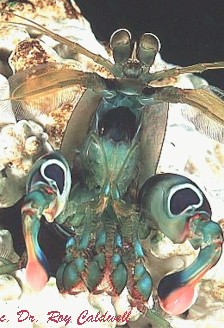Deception in Stomatopods
The use of threat displays by animals during intraspecific and interspecific competition for mates or for resources is very well-documented. These displays enable competitors to resolve their conflict by allowing them to size one another up without recourse to more drastic, and potentially injurious or fatal measures, such as actual fighting. The "weaker" animal usually gives way to the stronger, and loss of life or limb is avoided for both the winner and loser. This is especially important in those animals who possess natural weaponry that make it easy to kill others of their species (or related species) during the fights.
The stomatopod smashers vigorously compete for preformed cavities in rocks and corals, and most species in this group have developed a complex repertoire of acts to facilitate the ordered competition for this relatively scare resource. One of the most notable behavioral acts of stomatopods is the meral spread, in which the mantis shrimp elevates its cephalothorax, extends its antennules and antennal scales, and spreads its raptorial and other walking appendages. This serves not only to increase the apparent size of the animal, but it also exposes a brightly-colored depression on the dorsal surface of the merus of the raptorial appendage. This meral spot is different in color for different species, and its display is usually accurate in terms of predicting the aggressiveness of the signaler. For example, females guarding eggs tend to become more aggressive in defending their cavities, and also tend to display the meral spread more frequently than normal. Thus, the meral spread has become a significant deterrent to stomatopods invading the territory of the signaler, and it usually inhibits attacks by the invader.
| An individual Gonodactylus smithii, showing the conspicuous "dark purple on white" meral spots on its raptorial appendages. This particular species is especially prone to using the meral spread, and can sometimes bluff away much more aggressive species (Image used with permission of Dr. Roy Caldwell. Modified through addition of copyright information). |  |
The traditional view in ecology is that animal displays are almost always accurate barometers of the capabilities of the signaler, and that it is not possible for deception to become a stable feature of any such communication system. Deception in this case means that the signaler misrepresents its true capabilities in order to "win" a confrontation with a potential competitor. Ecologists argued that the widespread and continued use of deception by many individuals would cause the whole system to break down, as the recipients of the signal become more "skeptical" about its validity as more and more deceivers’ bluffs are called (IMO, this is somewhat analogous to Batesian mimicry in biological species, in which the mimicking individuals have to be present in much less numbers than the model in order for the whole thing to work).
Researchers working on stomatopod smashers have disagreed, and have shown that deception seems to be a stable feature in stomatopod communities. Their studies revealed that newly-moulted mantis shrimps frequently deceived potential competitors by engaging in the meral spread, even though their still-soft exoskeletons meant that they could not use their raptorial appendages without causing massive and serious damage to themselves.
Each experiment pitted a resident stomatopod (i.e. a mantis shrimp inside a cavity) against a newly-introduced intruder. Mantis shrimps have an extremely strong urge to huddle within enclosed spaces in order to hide their relatively unprotected rear ends. Since the test area contained only a single cavity, occupied by the resident, the new stomatopod immediately vied for ownership of the burrow by advancing on the resident, who was either a newly-moulted individual or an inter-moult control.
The scientists discovered that newly-moulted residents used the meral spread a significantly greater number of times than the inter-moult controls, and that many were able to deter the attacker, even though the latter would have had no trouble forcibly evicting or killing the still-soft resident had they chosen to call the bluff. In contrast, newly-moulted residents who did not show the display were much more likely to be damaged and forced out by the intruding mantis shrimps.
The fact that not all residents engage in the meral spread suggests that there are costs to its use. This cost is the much greater risk of injury or death for those who decide to bluff instead of immediately fleeing the area. Interestingly, the newly-moulted individuals in the experiments ameliorated their chances by bluffing more to those individuals who were more likely to be bluffed (in this case, to those intruders who were smaller or the same size as themselves). Residents commonly abandoned the cavities when faced with intruders who were much larger.
The persistence of this feature in stomatopod communities has been recently explained as being due to its intermittent use by only a segment of the total community. The potential costs associated with displaying the meral spread results in individuals of intermediate strength choosing not to use this threat display. Only the strongest individuals (who actually have the means to back up their threat) and the weakest (who may face greater risk when deprived of ready shelter and exposed to the many dangers of the outside world) tend to consistently engage in this act.
References
Web Site Author: A. Sunjian
Site Created February 3, 1998
Site Dedication